Hammurabi › The Army of Alexander the Great » Origins and History
Articles and Definitions › Contents
- Hammurabi › Who Was
- The Army of Alexander the Great › Antique Origins
Ancient civilizations › Historical places, and their characters
Hammurabi › Who Was
Definition and Origins
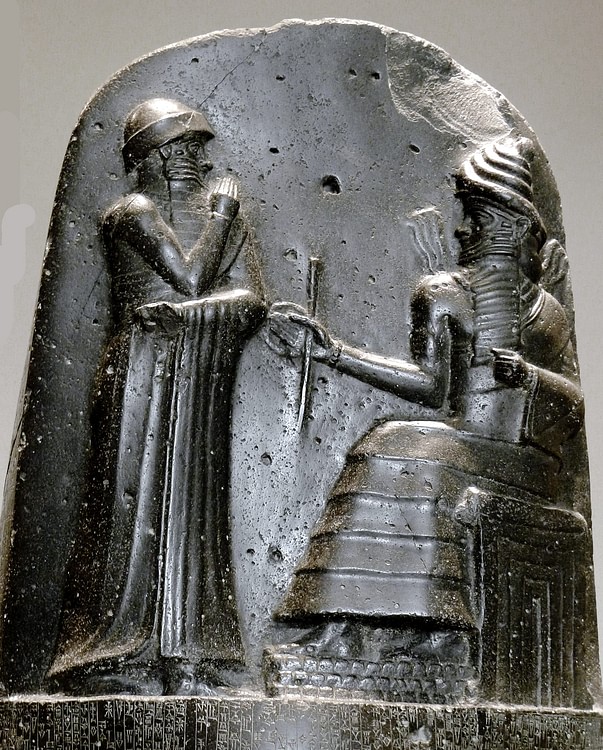
Hammurabi (also known as Khammurabi and Ammurapi, reigned 1792-1750 BCE) was the sixth king of the Amorite First Dynasty of Babylon, assumed the throne from his father, Sin-Muballit, and expanded the kingdom to conquer all of ancient Mesopotamia. The kingdom of Babylon comprised only the cities of Babylon, Kish, Sippar, and Borsippa when Hammurabi came to the throne but, through a succession of military campaigns, careful alliances made and broken when necessary, and political maneuvers, he held the entire region under Babylonian control by 1750 BCE.
According to his own inscriptions, letters and administrative documents from his reign, he sought to improve the lives of those who lived under his rule. He is best known in the modern day for his law code which, although not the earliest code of laws, came to serve as a model for other cultures and is thought to have influenced the laws set down by Hebrew scribes, including those from the biblical Book of Exodus.
CONQUERED CITIES WERE ABSORBED INTO HAMMURABI'S KINGDOM & THEN REPAIRED & IMPROVED UPON.
BACKGROUND & RISE TO POWER
The Amorites were a nomadic people who migrated across Mesopotamia from the coastal region of Eber Nari (modern day Syria ) at some point prior to the 3rd millennium BCE and by 1984 BCE were ruling in Babylon. The fifth king of the dynasty, Sin-Muballit (reigned 1812-1793 BCE), successfully completed many public works projects but was unable to expand the kingdom or compete with the rival city of Larsa to the south.
Larsa was the most lucrative trade center on the Persian Gulf and the profits from this trade enriched the city and encouraged expansion so that most of the cities of the south were under Larsa's control. Sin-Muballit led a force against Larsa but was defeated by their king Rim Sin I. At this point it is uncertain what exactly happened, but it seems that Sin-Muballit was compelled to abdicate in favor of his son Hammurabi. Whether Rim Sin I thought Hammurabi would be less of a threat to Larsa is also unknown but, if so, he would be proven wrong. The historian Durant writes:
At the outset of [Babylonian history] stands the powerful figure of Hammurabi, conqueror and lawgiver through a reign of forty-three years. Primeval seals and inscriptions transmit him to us partially – a youth full of fire and genius, a very whirlwind in battle, who crushes all rebels, cuts his enemies into pieces, marches over inaccessible mountains, and never loses an engagement. Under him the petty warring states of the lower valley were forced into unity and peace, and disciplined into order and security by an historic code of laws. (219)
Initially, Hammurabi gave Rim Sin I no cause for alarm. He began his reign by centralizing and streamlining his administration, continuing his father's building programs and enlarging and heightening the walls of the city. He instituted his famous code of laws (c. 1772 BCE), paid careful attention to the needs of the people, improved irrigation of fields and maintenance of the infrastructures of the cities under his control, while also building opulent temples to the gods. At the same time he was setting his troops in order and planning his campaign for the southern region of Mesopotamia.
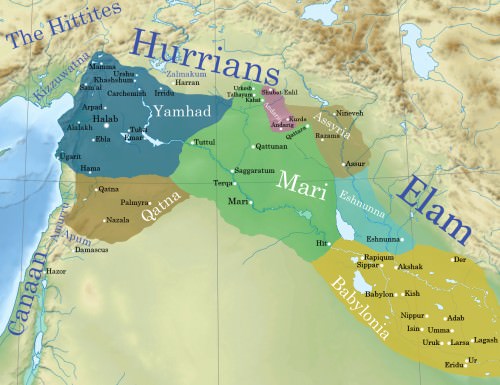
Ancient Syro-Mesopotamia ca. 1764 BCE
CONQUEROR OF MESOPOTAMIA
The scholar Stephen Bertman notes how Hammurabi's personal character worked to his advantage early in his reign:
Hammurabi was an able administrator, an adroit diplomat, and canny imperialist, patient in the achievement of his goals. Upon taking the throne, he issued a proclamation forgiving people's debts and during the first five years of his reign further enhanced his popularity by piously renovating the sanctuaries of the gods, especially Marduk, Babylon's patron. Then, with his power at home secure and his military forces primed, he began a five-year series of campaigns against rival states to the south and east, expanding his territory. (87)
When the Elamites invaded the central plains of Mesopotamia from the east, Hammurabi allied himself with Larsa to defeat them. That accomplished, he broke the alliance and swiftly took the cities of Uruk and Isin, previously held by Larsa, by forming alliances with other city-states such as Nippur and Lagash. The alliances he made with other states would repeatedly be broken when the king found it necessary to do so but, as rulers continued to enter into pacts with Hammurabi, it does not seem to have occurred to any of them that he would do the same to them as he had previously to others.
Once Uruk and Isin were conquered, he turned and took Nippur and Lagash and then conquered Larsa. A technique he seems to have used first in this engagement would become his preferred method in others when circumstances allowed: the damming up of water sources to the city to withhold them from the enemy until surrender or, possibly, withholding the waters through a dam and then releasing them to flood the city before then mounting an attack. This was a method previously used by Hammurabi's father but with considerably less efficacy. Larsa was the last stronghold of Rim Sin and, with its fall, there was no other force to stand against the king of Babylon in the south.
HAMMURABI STRUCK SWIFTLY AT MARI IN 1761 BCE &, FOR SOME REASON, DESTROYED IT INSTEAD OF SIMPLY CONQUERING IT.
With the southern part of Mesopotamia under control, Hammurabi turned north and west. The Amorite Kingdom of Mari in Syria had long been an ally of Amorite Babylon, and Hammurabi continued friendly relations with the king Zimri-Lim (reigned 1755-1761 BCE). Zimri-Lim had led successful military campaigns through the north of Mesopotamia and, owing to the wealth generated from these victories, Mari had grown to be the envy of other cities with one of the largest and most opulent palaces in the region.
Scholars have long debated why Hammurabi would break his alliance with Zimri-Lim but the reason seems fairly clear: Mari was an important, luxurious, and prosperous trade center on the Euphrates River and possessed great riches and, of course, water rights. Holding the city directly, instead of having to negotiate for resources, would be preferable to any ruler and certainly was so to Hammurabi. He struck swiftly at Mari in 1761 BCE and, for some reason, destroyed it instead of simply conquering it.
This is a much greater mystery than why he would march against it in the first place. Other conquered cities were absorbed into the kingdom and then repaired and improved upon. Why Mari was such an exception to Hammurabi's rule is still debated by scholars, but the reason could be as simple as that Hammurabi wanted Babylon to be the greatest of the Mesopotamian cities and Mari was a definite rival for this honor.
Zimri-Lim is thought to have been killed in this engagement as he vanishes from the historical record in that same year. From Mari, Hammurabi marched on Ashur and took the region of Assyria and finally Eshnunna (also conquered by damming up of the waters) so that, by 1755 BCE, he ruled all of Mesopotamia.

Law Code Tablet of King Hammurabi from Nippur
HAMMURABI'S CODE & THE CARE OF THE PEOPLE
Although Hammurabi spent a considerable amount of time on campaign, he made sure to provide for the people whose lands he ruled over. A popular title applied to Hammurabi in his lifetime was bani matim, 'builder of the land', because of the many building projects and canals he ordered constructed throughout the region.
Documents from the time attest to the efficacy of Hammurabi's rule and his sincere desire to improve the lives of the people of Mesopotamia. These letters and administrative works (such as directives for the building of canals, food distribution, beautification and building projects, and legal issues) support the view which Hammurabi held of himself. The prologue to his famous law code begins:
When the lofty Anu, King of the Annunaki and Bel, Lord of Heaven and Earth, he who determines the destiny of the land, committed the rule of all mankind to Marduk, when they pronounced the lofty name of Babylon, when they made it famous among the quarters of the world and in its midst established an everlasting kingdom whose foundations were firm as heaven and earth – at that time Anu and Bel called me, Hammurabi, the exalted prince, the worshipper of the gods, to cause justice to prevail in the land, to destroy the wicked and the evil, to prevent the strong from oppressing the weak, to enlighten the land and to further the welfare of the people. Hammurabi, the governor named by Bel, am I, who brought about plenty and abundance. (Durant, 219)

Hammurabi's Law Code
His law code is not the first such code in history (though it is often called so) but is certainly the most famous from antiquity prior to the code set down in the biblical books. The Code of Ur-Nammu (c. 2100-2050 BCE), which originated with either Ur -Nammu or his son Shulgi of Ur, is the oldest code of laws in the world. Hammurabi's code differed from the earlier laws in significant ways. The historian Kriwaczek explains this, writing :
Hammurabi's laws reflect the shock of an unprecedented social environment: the multi-ethnic, multi-tribal Babylonian world. In earlier Sumerian-Akkadian times, all communities had felt themselves to be joint members of the same family, all equally servants under the eyes of the gods. In such circumstances disputes could be settled by recourse to a collectively accepted value system, where blood was thicker than water, and fair restitution more desirable than revenge. Now, however, when urban citizens commonly rubbed shoulders with nomads following a completely different way of life, when speakers of several west Semitic Amurru languages, as well as others, were thrown together with uncomprehending Akkadians, confrontation must all too easily have spilled over into conflict. Vendettas and blood feuds must often have threatened the cohesion of the empire.(180)
The Code of Ur-Nammu certainly relies on the concept of “joint members of the same family” in that an underlying understanding by the people of proper behavior in society is assumed throughout. Everyone under the law was expected to already know what the gods required of them, and the king was expected simply to administer the god's will. Historian Karen Rhea Nemet-Najat writes:
The king was directly responsible for administering justice on behalf of the gods, who had established law and order in the universe. (221)

Cuneiform Tablet Listing the Names of Old Babylonian Kings
If a man put out the eye of another man, his eye shall be put out.If he break another man's bone, his bone shall be broken.If a man knock out the teeth of his equal, his teeth shall be knocked out.If a builder build a house for someone, and does not construct it properly,And the house which he built fall in and kill its owner, then that builder shall be put to death.If it kill the son of the owner of the house, the son of that builder shall be put to death.
Unlike the earlier Code of Ur-Nammu, which imposed fines or penalties of land, Hammurabi's code epitomized the principle known as Lex Talionis, the law of retributive justice, in which punishment corresponds directly to the crime, better known as the concept of 'an eye for an eye and a tooth for a tooth', made famous from the later law code of the Old Testament, exemplified in this passage from the Book of Exodus:
If people are fighting and hit a pregnant woman and she gives birth prematurely but there is no serious injury, the offender must be fined whatever the woman's husband demands and the court allows. But if there is serious injury, you are to take life for life, eye for eye, tooth for tooth, hand for hand, foot for foot, burn for burn, wound for wound, bruise for bruise. (Exodus 21:22-25)
HAMMURABI'S LAW CODE SET THE STANDARD FOR FUTURE CODES IN DEALING STRICTLY WITH THE EVIDENCE OF THE CRIME & SETTING A SPECIFIC PUNISHMENT.
Hammurabi's law code thus set the standard for future codes in dealing strictly with the evidence of the crime and setting a specific punishment for that crime. What decided one's guilt or innocence, however, was the much older method of the Ordeal, in which an accused person was sentenced to perform a certain task (usually being thrown into a river or having to swim a certain distance across a river) and, if they succeeded, they were innocent and, if not, they were guilty. Hammurabi's code stipulates that:
If a man's wife has been pointed out because of another man, even though she has not been caught with him, for her husband's sake she must plunge into the divine river.
The woman who did so and survived the ordeal would be recognized as innocent, but then her accuser would be found guilty of false witness and punished by death. The ordeal was resorted to regularly in what were considered the most serious crimes, adultery and sorcery, because it was thought these two infractions were most likely to undermine social stability. Sorcery, to an ancient Mesopotamian, would not have exactly the same definition as it does in the modern day but would be along the lines of performing acts that went against the known will of the gods -- acts which reflected on oneself the kind of power and prestige only the gods could lay claim to. Tales of evil sorcerers and sorceresses are found throughout many periods of Mesopotamian history and the writers of these tales always have them meet with a bad end as, it seems, they also did when submitted to the Ordeal.

King Hammurapi at Worship
HAMMURABI'S DEATH & LEGACY
By 1755 BCE, when he was the undisputed master of Mesopotamia, Hammurabi was old and sick. In the last years of his life his son, Samsu-Iluna, had already taken over the responsibilities of the throne and assumed full reign in 1749 BCE. The conquest of Eshnunna had removed a barrier to the east that had buffered the region against incursions by people such as the Hittites and Kassites. Once that barrier was gone, and news of the great king weakening spread, the eastern tribes prepared their armies to invade. Hammurabi died in 1750 BCE, and Samsu-Iluna was left to hold his father's realm against the invading forces while also keeping the various regions of Babylonia under control of the city of Babylon; it was a formidable task of which he was not capable.
THE VAST KINGDOM HAMMURABI HAD BUILT DURING HIS LIFETIME BEGAN TO FALL APART WITHIN A YEAR OF HIS DEATH
The vast kingdom Hammurabi had built during his lifetime began to fall apart within a year of his death, and those cities that had been part of vassal states secured their borders and announced their autonomy. None of Hammurabi's successors could put the kingdom back together again, and first the Hittites (in 1595 BCE), then the Kassites invaded.
The Hittites sacked Babylon and the Kassites inhabited and re-named it. The Elamites, who had been so completely defeated by Hammurabi decades before, invaded and carried off the stele of Hammurabi's Law Code which was discovered at the Elamite city of Susa in 1902 CE.
Hammurabi is best remembered today as a lawgiver whose code served as a standard for later laws but, in his time, he was known as the ruler who united Mesopotamia under a single governing body in the same way Sargon the Great of Akkad had done centuries before. He linked himself with great imperialists like Sargon by proclaiming himself “the mighty king, king of Babylon, king of the Four Regions of the World, king of Sumer and Akkad, into whose power the god Bel has given over land and people, in whose hand he has placed the reins of government” and, just like Sargon (and others), claimed his legitimate rule was ordained by the will of the gods.
Unlike Sargon the Great, however, whose multi-ethnic empire was continually torn by internecine strife, Hammurabi ruled over a kingdom whose people enjoyed relative peace following his conquest. The scholar Gwendolyn Leick writes:
Hammurabi remains one of the great kings of Mesopotamia, an outstanding diplomat and negotiator who was patient enough to wait for the right time and then ruthless enough to achieve his aims without stretching his resources too far. (83)
It is a testimony to his rule that, unlike Sargon or his grandson Naram-Sin from earlier times, Hammurabi did not have to re-conquer cities and regions repeatedly but, having brought them under Babylonian rule, was, for the most part, interested in improving them and the standard of living of the inhabitants (a notable exception being Mari, of course). His legacy as a lawgiver reflects his genuine concern for social justice and the betterment of the lives of his people.
The Army of Alexander the Great › Antique Origins
Ancient Civilizations
No military commander in history has ever won a battle by himself. To be successful he needs the support of a well-trained army who will follow him regardless of the cost whether it be a stunning victory or hopeless defeat. One need only read of Leonidas as he bravely led his 300 Spartans to inevitable defeat at Thermopylae. History has had its share of skilled leaders - Julius Caesar, Hannibal, and later Napoleon. However, all three of these men must pay homage to a single individual and his army. Alexander the Great conquered most of the known world of his time. From his father King Philip of Macedonia he inherited a versatile, well-trained army unlike anything that had ever existed. United in a single purpose, they fought as one.Alexander recognized this and is quoted as saying, “Remember upon the conduct of each depends the fate of all.”
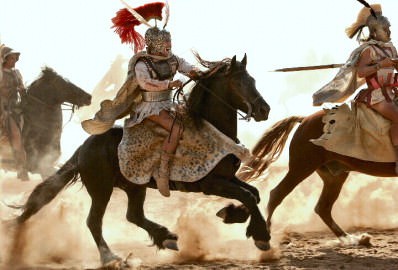
Alexander the Great in Combat
Although he owes much of his success to his father's foresight, the young king's achievements in battle can be traced back to the origin of the hoplite phalanx of early Greece. Around 700 BCE the cities of Corinth, Sparta, and Argos created a close-ordered battle formation that became known as the phalanx. The reason for this development was due in part to a changing Greece. Greece was emerging from a dark period in its history - the troubling times of the poet Homer. There was the emergence of the polis or city-state and the expansion of colonies founded as near as Ionia and as far away as Sicily.With trade and the Greek world expanding, for political and economic reasons, each city had to learn to defend itself.
EARLIER GREEK WARFARE
Two powerful city-states rose to dominate Greece. While Athens would become a naval power, Sparta easily emerged as the atypical military city, initiating a strict code of conduct with intense military training for every male citizen. It was the birth of the citizen-warrior. Every citizen was required to defend the city in the event of war. Although a Spartan boy learned enough to be literate, more importantly, he learned how to endure pain and to conquer in battle, in essence to fight as a unit not as an individual. The city itself was like an armed camp. This intense training became evident when Greece was invaded by the Persians under the command of Darius I and later his son Xerxes.
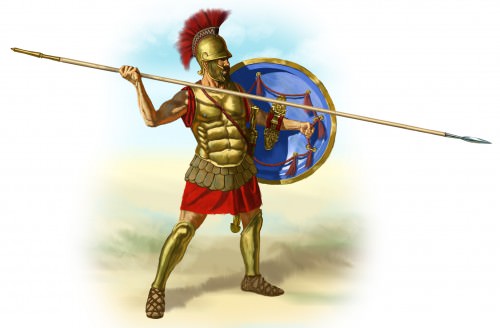
Greek Hoplite
The new soldier was a hoplite, named for the hoplon, his shield. For additional protection he wore a helmet (most often the Corinthian style), covering most of his face except for a t-shaped opening that exposed his eyes, nose and mouth (unfortunately, it did not allow for peripheral vision); Philip would replace this with a Phrygian helmet that allowed for better hearing and visibility. The hoplite wore greaves to cover his calves, a molded cuirass that shielded his torso as well as a long, pleated tunic that protected his abdomen and groin. For a weapon he carried a thrusting spear of five to eight feet in length.The army marched in a close-ordered formation or phalanx where each hoplite carried his shield in a manner that protected his left side and his neighbor's right. This new style of fighting was primarily offensive, advancing in a line into the center of the opposing enemy.
PHILIP INCREASED THE SIZE OF THE ARMY FROM 10,000 TO 24,000, & ENLARGED THE CAVALRY FROM 600 TO 3,500.
A DISCIPLINED & ORGANIZED ARMY
When Philip II became king of Macedonia in 359 BCE, he inherited an army that was relatively ineffective. He immediately initiated a series of military reforms. Together, Alexander and his father would create an army unlike anything the ancient world had even seen. Previous wars such as the Persian and Peloponnesian War had demonstrated that the old ways were no longer dependable. Philip took a poorly disciplined group of men and turned them into a formidable army. Most historians believed Philip developed his ideas while a hostage in Thebes, observing their notorious Sacred Band. To begin with, he increased the size of the army from 10,000 to 24,000, and enlarged the cavalry from 600 to 3,500; this was no longer an army of citizen-warriors. In addition, he created a corp of engineers to develop siege weaponry such as towers and catapults. Later, Alexander would use these siege towers with devastating effect at Tyre (6,000 would be killed and 30,000 enslaved).
The very nature of the phalanx required constant drilling, and both men demanded strict obedience; punishments would be meted out for those who disobeyed. Like Alexander after him, Philip required an oath of swearing allegiance to the king. They provided uniforms - a simple idea that gave each man a sense of unity and solidarity. Besides the obvious, there was logic behind what they did; each soldier would no longer be loyal to a particular province or town as now he would be loyal only to the king. The battle-hardened men who fought for Philip and Alexander had to remain dedicated to his king and the glory of Macedonia. This loyalty and restructuring became evident at Philip's victory over Athens and Thebes (with the help of an eighteen year old Alexander) at the Battle of Chaeronea ; a battle that demonstrated the power and authority of Macedonia.

Battle of Chaeronia
Philip completely restructured the army. The first order of business was the reorganization of the phalanx, providing each individual unit with its own commander - thereby allowing for better communication. The fundamental fighting unit became the taxes which usually comprised 1,540 men and commanded by a taxiarch. Every taxis was broken into distinct subdivisions. A taxis was composed of three lochoi (each commanded by a lochagos ) or 512 men apiece. 32 dekas (a line of ten men – later sixteen) made up each lochoi. Each man occupied only two cubits of space until actual battle, when he used only one cubit.
WEAPONS & TACTICS
Next, Philip changed the principal weaponry from the hoplite spear to the sarissa - an 18-20 feet pike; it had the advantage of reaching over the much shorter spears of the opposition. Obviously, the length of the sarissa made it difficult to handle, demanding both strength and dexterity. The hoplite now became a pezhetairoi or foot companion. Like his predecessor, he, too, carried a shield or aspis - similar to the hoplon, but due to the size of the sarissa (one had to use both hands); it was carried by a sling over the shoulder. Besides the sarissa, each man possessed a smaller double-edge sword or xiphos for close-in-hand fighting.
There was only one drawback to the phalanx - it worked best on flat, unbroken country; however, despite this disadvantage, Alexander used it with amazing success. In almost every campaign the formation of Alexander's army remained the same;however, due to the nature of the field of battle, some changes were made at Hydaspes where archers led the field against Porus' elephants. The pezhetairoi were in the center; the hypaspists were to their right with the cavalry on either flank. Archers and additional lighter infantry served on outer flanks and in the rear. The pezhetairoi were indoctrinated to maintain ranks in all circumstances, although they were able to break smoothly when necessary; this was evident at Gaugamela against Darius ' scythed chariots. In battle, the five front ranks lowered their sarissa parallel to the ground while the rear ranks (usually wearing broad-brimmed a straw hat or kausia instead of helmets) carried theirs upright.
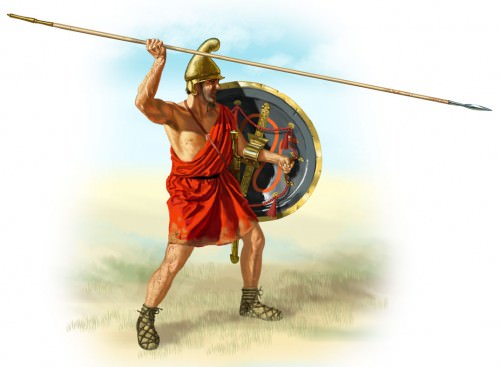
Hypaspist
As indicated earlier, to the right of these pezhetairoi were the far more mobile hypaspists also called shield-bearers. Although not as heavily armed - carrying only a shorter spear or javelin - they served a special role in both Philip and Alexander's army.They were recruited for their skill and physique, requiring a special level of training. They were mostly from the peasantry of Macedon and, thereby, had no tribal or regional affiliation meaning they loyal only to the king himself. There were three distinct classes of hypaspists - the “royal” who served as the bodyguards of the king as well as guards at banquets and official events, an elite force known as the argyraspids, and finally the actual hypaspists corp. A special band of veterans within the hypaspists would become known as the Silver Shields.
CAVALRY
On both the right and left flanks were the cavalry. The cavalry was the army's main strike force and would make the decisive breakthrough of the enemy lines - this was evident at the battles of Granicus, Issus and Gaugamela. There were two divisions of the cavalry - the Companion and the prodromoi - the latter was the more flexible and versatile Balkan cavalry which was used primarily as scouts. The Companion Cavalry was the more important division and was commanded at first by Philotas and later by Cleitus and Hephaestion. They were divided into eight squadrons of 200 men each and each man carried a nine-foot lance but wore little armor. Due to the extreme value of the cavalry - 1,000 horses would die at Gaugamela - a steady supply of extra horses was kept at all times. Of course, the most important of these squadrons was that of Alexander.Alexander and his Royal Companions always fought on the right while Parmenio commanded the Thessalian Cavalry on the left flank. Tactics remained simple - the pezhetairoi would hit the center of the opposing army in an oblique angle while the cavalry would attack and punch holes on the flanks. As with the previously abandoned hoplite phalanx, the new army was designed to attack and remained a purely offensive weapon. While well-trained soldiers are always essential for success, an army needs capable leadership, and besides Alexander, the force that crossed the Hellespont had several capable officers, namely Parmenio, Perdiccos, Coenus, Cleitus, Ptolemy, and Hephaestion.
Alexander ran his army from the royal tent where his war counsel would meet in a large pavilion. The tent also contained a vestibule, an armory and the king's personal apartment. The tent was guarded at all times by a special detachment of hypaspists. Although he would always listen to the suggestions of his command staff, Alexander's decision was final. This was most evident before the battle at Gaugamela when Parmenio and a number of other officers suggested Alexander attack Darius at night which Alexander, of course, flatly refused: “I will not steal a victory.”
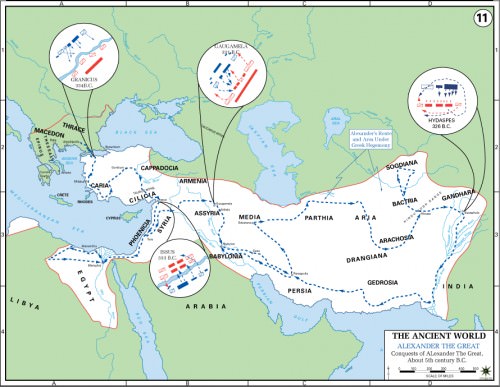
Map of Alexander the Great's Conquests
CROSSING THE HELLESPONT
When he entered Asia, the young king brought with him 12,000 phalangists - 9,000 pezhetairoi and 3,000 hypaspists. He also brought with him over 7,000 Greek infantry, most of which would be used to maintain conquered lands as garrison troops.While the army that crossed the Hellespont in 334 BCE was mostly Macedonian, there were others from all over Greece: Agrianians, Triballians, Paeonians, and Illyrians. Since Alexander was also the head of the Legion of Corinth, a number of Greek states provided additional infantry, cavalry and warships. Many of these mercenaries spoke a variety of dialects and came from provinces with a long history of ethnic tension. Luckily, this tension was kept to a minimum. After the defeat of Darius III at Gaugamela in 331 BCE, Alexander realized it was necessary to replace his force's depleted numbers, welcoming new recruits into his army among which were a number of Persians whilst some of his veterans were sent home. All new recruits, whether those arriving from Macedonia or others recruited from local provinces, were trained in the Macedonian style of fighting.
ALEXANDER'S LEADERSHIP
However, an army - even one that was as well-trained as that from Macedonia - could not have functioned as well without the capable leadership of Alexander. In his book Masters of Command: Alexander, Hannibal and Caesar, author Barry Strauss composed a list of traits necessary for good leadership and among them are judgment, audacity, agility, strategy, and terror.Alexander displayed all of these qualities. Although he would show respect for his enemy, as demonstrated after Issus, he was afraid of no one. He is quoted as saying, “I am not afraid of an army of lions led by a sheep; I am afraid of an army of sheep led by a lion.” One of his remarkable abilities was to anticipate the strategy of his opponent, often drawing him onto the terrain of his choosing, once again, this is most visible at Gaugamela. Throughout his conquest of Persia, Alexander didn't necessarily want to bring Darius to his knees; he only wanted to conquer.

Alexander the Great
Alexander had the respect of his men and never betrayed their trust as he fought next to them, ate with them, and refused to drink water when there wasn't enough for all. Quite simply, he set the example. As was evident at Gaugamela, he was able to rally his men to fight with him. Plutarch in his Life of Alexander the Great wrote,
…he made a very long speech to the Thessalians and the other Greeks and when he saw that they encouraged him with shouts to lead them against the Barbarians, he shifted his lance into his left hand, and with his right appealed to the gods…praying them, if he was really sprung from Zeus, to defend and strengthen the Greeks…and after mutual encouragement and exhortations the cavalry charged at full speed upon the enemy…
In his The Campaigns of Alexander Arrian quoted Alexander as he addressed his troops:
…we of Macedon for generations past have been trained in the hard school of danger and war. [The king compared the two armies - that of Macedon and that of Persia] …and what, finally, of the two men in supreme command? You have Alexander, they Darius.
Before Philip and Alexander, the Persians under Darius I and Xerxes had been repelled by a smaller force - these men of Greece fought unlike anyone and anything the Persians had ever experienced. By the time of Alexander, the fighting force that took him across both Greece and Persia had been perfected. He crossed Asia into India, often fighting a force that outnumbered him. His use of the phalanx and cavalry, combined with an innate sense of command, put his enemy on the defensive, enabling him to never lose a battle. His memory would live on and his determination brought the Hellenic culture to Asia. He built great cities and changed forever the customs of a people.
LICENSE:
Article based on information obtained from these sources:with permission from the Website Ancient History Encyclopedia
Content is available under License Creative Commons: Attribution-NonCommercial-ShareAlike 3.0 Unported. CC-BY-NC-SA License